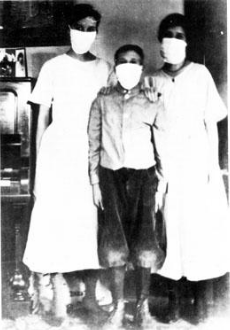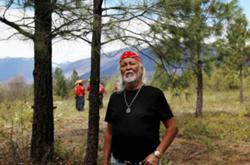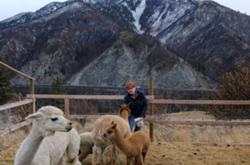
The grim prospect of an avian flu epidemic is beginning to register widely on the public's imagination. Still, after all these months of monitoring avian flu, we still seem very hazy about the scope of a possible pandemic. The most likely analogy is the Spanish flu of 1918-19, but even there the analogy is weak.
First, medical science was far less advanced than it is now. If Spanish flu had erupted in 1998, say, it would have caused millions of deaths, especially in the less developed world. But the industrial nations would have done far better than they did in 1918.
On the other hand, transportation is far faster than it was at the end of World War I. Many soldiers in the trenches died of flu in hospitals within sound of the guns. US soldiers falling ill today in Iraq or Uzbekistan are likely to be in Germany within hours, if not back home. A wounded soldier with an early case of flu could spread it across thousands of kilometers before anyone noticed.
But let us consider that H5N1 on balance is just about as deadly as Spanish flu was. How would we fare against it?
Twelve terrible weeks
John M. Barry, in his book The Great Influenza, notes that the pandemic lasted two years, but was at its worst over just 12 weeks in the fall of 1918. At that time the earth's population was 1.8 billion-about one-third of today's.
The most recent estimates are that 20 percent of the 1918 world population was infected; in some regions the infection rate was essentially 100 percent, while in others it was quite low. In the US, about 28 percent of 105 million were infected.
The mortality rate also varied. In the US, about 675,000 died, or about 0.65 percent of the total population. Bryan says Italy lost 1 percent, and Mexico somewhere between 2.3 percent and 4 percent. Perhaps 5 to 9 percent of all the young adults in the world died in the 1918-19 pandemic, and the total deaths may have been as high as 100 million. That would have been around 5 percent of the world population. Apparently the only area to escape the Spanish flu altogether was an island in the mouth of the Amazon River. Many native communities in Alaska and the Pacific islands were exterminated.
Another Great Influenza?
In creating a scenario for a new pandemic, let's ignore the regional variations and stick with a world average of 20 percent infections and loss of 2.5 percent of the total population. That's just half of the estimated death rate in 1918-19. Let's also assume that we get a first wave in the spring of 2006, a severe wave in the fall, and then dwindling cases in 2007 and 2008.
With 6.4 billion people, that means 1.28 billion cases of avian flu worldwide. It also means 160 million deaths, the great majority of them occurring in three months.
My own college has a total of 8,000 students, faculty, and staff. About 1,600 of us would be infected, including 100 faculty. Forty of us would die. British Columbia has just over 4 million inhabitants. With a 20 percent "attack rate," 800,000 of us would get sick. With 2.5 percent of us dying, we would lose 100,000 British Columbians.
In Canada, 6.4 million of our 32 million would be infected. The death toll would be 800,000. In the US, about 60 million infections would lead to 7.5 million deaths. (Total US deaths from all causes in 2002 were about 2.4 million, with influenza and pneumonia killing 65,000.)
China's 1.3 billion would suffer 260 million cases and would lose 37 million to the flu.
Danger for mothers and babies
The US National Center for Health Statistics estimates that 6.4 million pregnancies ended in the year 2000. Discounting the 1 million miscarriages and 1.3 million abortions, that meant just over 4 million live births. Assume 4 million pregnant Americans in a pandemic, with a 20 percent infection rate. That means 800,000 women. In 1918, the death rate from influenza among infected pregnant women ranged from 23 to 71 percent. Let's say 30 percent mortality in 2006: 240,000 US deaths in this group alone.
Moreover, a quarter of the pregnant survivors of Spanish flu lost their babies. That suggests an additional 140,000 US deaths in 2006. And a recent report suggests that many babies in utero during the pandemic suffered lifelong physical and intellectual damage because of their mothers' illness. So the new pandemic's effects could last long into the 21st century.
Assume that avian flu also selectively attacks and kills more young adults, as Spanish flu did. If the young adult population suffers 5 percent mortality, twice the average I'm suggesting, we can expect the 150,000 US forces in Iraq to lose 7,500 young men and women to avian influenza. It may be some consolation to reflect that the insurgents will suffer proportionally, and receive less effective medical care.
Collateral damage
Meanwhile, people would also go on dying of heart disease, cancer, stroke, Alzheimer's and all the other diseases. With little or no health care available at the peak of the pandemic, death rates from those diseases would also rise sharply. I realize that most estimates by government health agencies are far lower than the ones I suggest here. The Public Health Agency of Canada, for example, says that between 11,000 and 58,000 Canadian deaths could occur from a new flu virus infecting between 15 and 35 percent of the population. The BC Centre for Disease Control forecasts 6,800 deaths from a 1968-style pandemic, but makes no estimates for something on the scale of Spanish flu.
My 5 percent total mortality figure may be wildly pessimistic. Assume that I'm quintupling the real death toll; if just 1 percent of humanity dies from a flu pandemic in the next couple of years, that will be 64 million deaths in excess of the 50 million or so worldwide "natural" deaths every year.
But this is just a simple arithmetical extrapolation from the generally accepted numbers of 1918-19 to the possible numbers of a modern pandemic. (If I have made errors in calculation, I look forward to prompt corrections.)
As huge as the numbers may be, we would individually experience the pandemic on smaller terms: In a college with 8,000 persons, no one would know all 40 of the dead.
But the pandemic would not be smooth. Some communities would escape with just a few cases, or none at all. Others would suffer terribly. All would endure months of severe anxiety and dislocation, and would emerge poorer and less functional than before the pandemic.
Perhaps the survivors would simply try to forget the trauma and get on with life. But we can hope that a more thoughtful and humane world will recall the price paid for ignorance and wishful thinking-and choose never to pay such a price again.
Crawford Kilian, a frequent contributor to The Tyee, follows avian influenza here. ![]()
















Tyee Commenting Guidelines
Comments that violate guidelines risk being deleted, and violations may result in a temporary or permanent user ban. Maintain the spirit of good conversation to stay in the discussion.
*Please note The Tyee is not a forum for spreading misinformation about COVID-19, denying its existence or minimizing its risk to public health.
Do:
Do not: